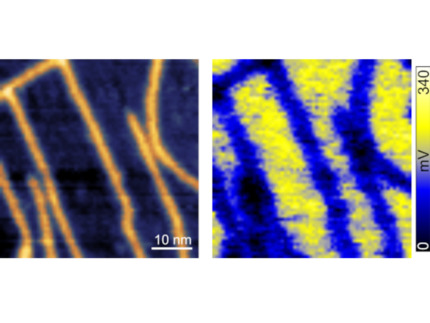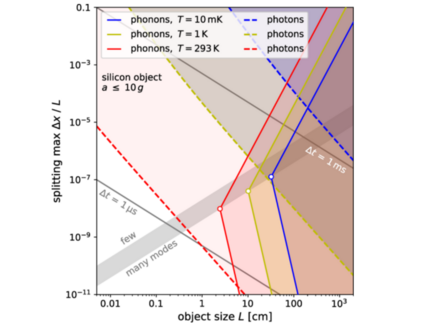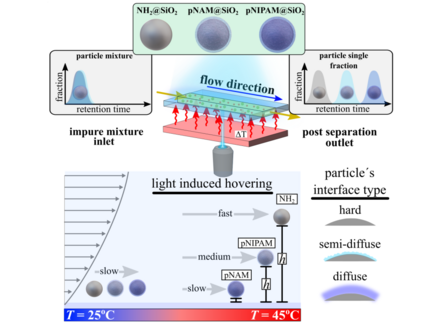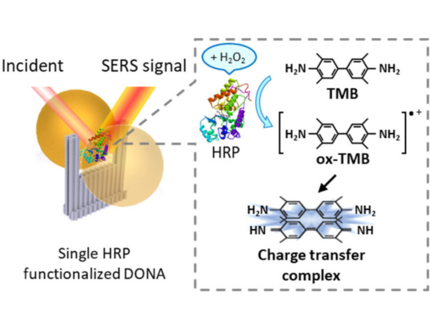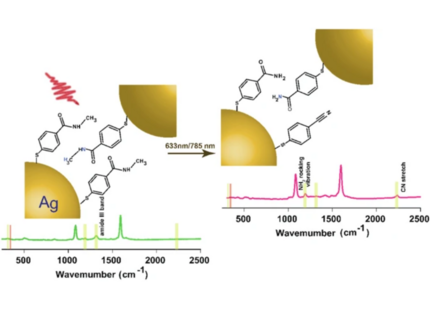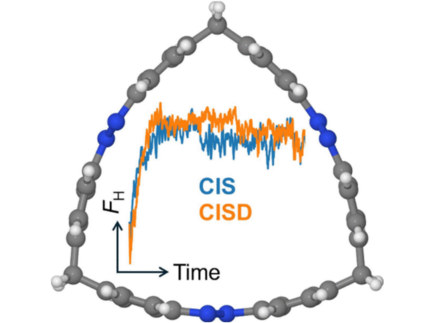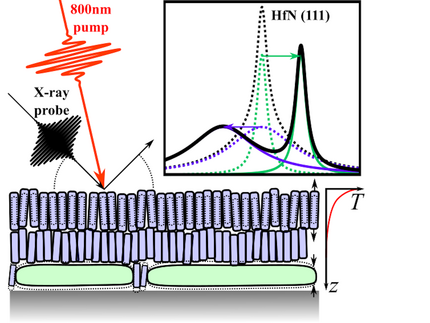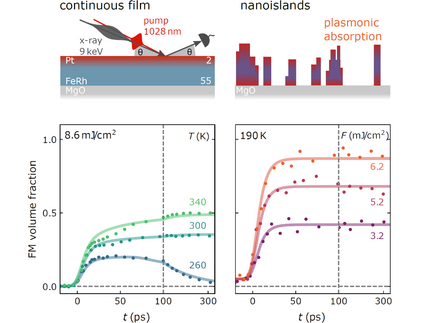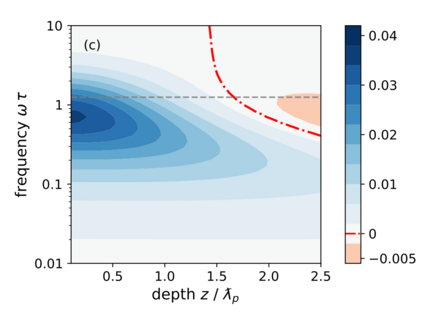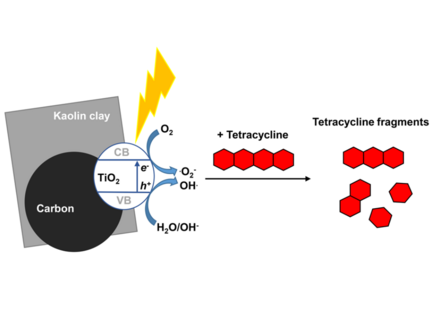D. Rothhardt, A. Kimouche, T. Klamroth and R. Hoffmann-Vogel
Local work function on graphene nanoribbons
Beilstein Journal of Nanotechnology, 2024, 15, 1125–1131
Graphene nanoribbons show exciting electronic properties related to the exotic nature of the charge carriers and to local confinement as well as atomic-scale structural details. The local work function provides evidence for such structural, electronic, and chemical variations at surfaces. Kelvin prove force microscopy can be used to measure the local contact potential difference (LCPD) between a probe tip and a surface, related to the work function. Here we use this technique to map the LCPD of graphene nanoribbons grown on a Au(111) substrate. The LCPD data shows charge transfer between the graphene nanoribbons and the gold substrate. Our results are corroborated with density functional theory calculations, which verify that the maps reflect the doping of the nanoribbons. Our results help to understand the relation between atomic structure and electronic properties both in high-resolution images and in the distance dependence of the LCPD.
C. Henkel and R. Folman
Universal limit on spatial quantum superpositions with massive objects due to phonons
Physical Review A, 2024, 110, 042221
It has been a long-standing goal to bring massive objects into a superposition of different locations in real space, not only to confirm quantum theory in new regimes, but also to explore the interface with gravity. The main challenge is usually thought to arise from forces or scattering due to environmental fields and particles that decohere the large object's wave function into a statistical mixture. We unveil a decoherence channel which cannot be eliminated by improved isolation from the environment. It originates from sound waves within the object, which are excited as part of any splitting process and carry partial Welcher Weg information. This puts stringent constraints on future spatial superpositions of large objects.
A. Stefancu, J. Aizpurua, I. Alessandri, I. Bald, J. J. Baumberg, L. V. Besteiro, P. Christopher, M. Correa-Duarte, B. de Nijs, A. Demetriadou, R. R. Frontiera, T. Fukushima, N. J. Halas, P. K. Jain, Z. Hwan Kim, S. Kurouski, H. Lange, J.-F. Li, L. M. Liz-Marzán, I. T. Lucas, A. J. Meixner, K. Murakoshi, P. Nordlander, W. J. Peveler, R. Quesada-Cabrera, E. Ringe, G. C. Schatz, S. Schlücker, Z. D. Schultz, E. Xi Tan, Z.-Q. Tian, L. Wang, B. M. Weckhuysen, Q. Xie, X. Yi Ling, J. Zhang, Z. Zhao, R.-Y. Zhou, E. Cortés
Impact of Surface Enhanced Raman Spectroscopy in Catalysis
ACS Nano, 2024, 18, 29337 - 29379
Catalysis stands as an indispensable cornerstone of modern society, underpinning the production of over 80% of manufactured goods and driving over 90% of industrial chemical processes. As the demand for more efficient and sustainable processes grows, better catalysts are needed. Understanding the working principles of catalysts is key, and over the last 50 years, surface-enhanced Raman Spectroscopy (SERS) has become essential. Discovered in 1974, SERS has evolved into a mature and powerful analytical tool, transforming the way in which we detect molecules across disciplines. In catalysis, SERS has enabled insights into dynamic surface phenomena, facilitating the monitoring of the catalyst structure, adsorbate interactions, and reaction kinetics at very high spatial and temporal resolutions. This review explores the achievements as well as the future potential of SERS in the field of catalysis and energy conversion, thereby highlighting its role in advancing these critical areas of research.
D. Vasquez-Muñoz, F. Rohne, I. Meier, C. Braksch, N. Lomadze, A. Heraji Esfahani, A. Nitschke, A. Taubert, S. Santer, M. Hartlieb, and M. Bekir
Separation of Surface Grafted Microparticles via Light and Temperature
Separation of equally sized particles distinguished solely by interfacial properties remains a highly challenging task. Herein, a particle fractioning method is proposed, which is suitable to differentiate between polymer-grafted microparticles that are equal in size. The separation relies on the combination of a pressure driven microfluidic flow, together with simultaneous light illumination and temperature control. Heating the solution forces thermo-responsive surface grafts to undergo a volume phase transition and therefore locally changing the interfacial properties of the microparticles. Light illumination induces the phoretic/ osmotic activity of the microparticles and lifts them into a higher plane, where hovering particles experience a different shear stress proportional to the height. The light-induced hovering height depends on the interfacial properties, and this complex interaction leads to different movements of the microparticles as a function of their surface grafting. The concepts are visualized in experimental studies, where the complex physical principle provides a simple method for fractioning a binary mixture with at least one thermo-responsive polymer graft.
Y. Kanehira, S. Kogikoski Jr., E. Titov, K. Tapio, A. Mostafa, I. Bald
Watching a Single Enzyme at Work Using Single-Molecule Surface-Enhanced Raman Scattering and DNA Origami-Based Plasmonic Antennas
ACS Nano, 2024, 18, 20191-20200
The detection of a single-enzyme catalytic reaction by surfaced-enhanced Raman scattering (SERS) is presented by utilizing DNA origami-based plasmonic antennas. A single horseradish peroxidase (HRP) was accommodated on a DNA origami nanofork plasmonic antenna (DONA) containing gold nanoparticles, enabling the tracing of single-molecule SERS signals during the peroxide reduction reaction. This allows monitoring of the structure of a single enzymatic catalytic center and products under suitable liquid conditions. Herein, we demonstrate the chemical changes of HRP and the appearance of tetramethylbenzidine (TMB), which works as a hydrogen donor before and after the catalytic reaction. The results show that the iron in HRP adopts Fe4+ and low spin states with the introduction of H2O2, indicating compound-I formation. Density functional theory (DFT) calculations were performed for later catalytic steps to rationalize the experimental Raman/SERS spectra. The presented data provide several possibilities for tracking single biomolecules in situ during a chemical reaction and further developing plasmon-enhanced biocatalysis.
A. Dutta, M. Ončák, F. Izadi, E. Arthur-Baidoo, J. Ameixa, S. Denifl, I. Bald
Plasmon-driven chemical transformation of a secondary amide probed by surface enhanced Raman scattering
Commuications Chemistry, 2024, 7, 188
Plasmon-driven chemical conversion is gaining burgeoning interest in the field of heterogeneous catalysis. Herein, we study the reactivity of N-methyl-4-sulfanylbenzamide (NMSB) at nanocavities of gold and silver nanoparticle aggregates under plasmonic excitation to gain understanding of the respective reaction mechanism. NMSB is a secondary amide, which is a frequent binding motive found in peptides and a common coupling product of organic molecules and biomolecules. Surface-enhanced Raman scattering (SERS) is used as a two-in-one in-situ spectroscopic tool to initiate the molecular transformation process and simultaneously monitor and analyze the reaction products. Supported by dissociative electron attachment (DEA) studies with the gas phase molecule, a hot electron-mediated conversion of NMSB to p-mercaptobenzamide and p-mercaptobenzonitrile is proposed at the plasmonic nanocavities. The reaction rate showed negligible dependence on the external temperature, ruling out the dominant role of heat in the chemical transformation at the plasmonic interface. This is reflected in the absence of a superlinear relationship between the reaction rate constant and the laser power density, and DEA and SERS studies indicate a hot-electron mediated pathway. We conclude that the overall reaction rate is limited by the availability of energetic hot electrons to the NMSB molecule.
E. Titov
The Role of Double Excitations in Exciton Dynamics of Multiazobenzenes: Trisazobenzenophane as a Test Case
Journal of Physical Chemistry Letters 2024, 15, 7482–7488
Molecular exciton dynamics underlie energy and charge transfer processes in organic multichromophoric systems. A particularly interesting class of the latter is multiphotochromic systems made of molecules capable of photochemical transformations. Exciton dynamics in assemblies of photoswitches have been recently investigated using either the molecular exciton model or supermolecular configuration interaction (CI) singles, both approaches being based on a semiempirical Hamiltonian and combined with surface hopping molecular dynamics. Here, we study how inclusion of double excitations in nonadiabatic dynamics simulations affects exciton dynamics of multiazobenzenes, using trisazobenzenophane as an example. We find that both CI singles and CI singles and doubles yield virtually the same time scale of dynamical exciton localization, ∼50 fs for the studied multiazobenzene. However, inclusion of double excitations considerably affects the excited state lifetimes and isomerization quantum yields.
S. P. Zeuschner, J.-E. Pudell, M. Mattern, M. Rössle, M. Herzog, A. Baldi, S.H. C. Askes, M. Bargheer
Unveiling the Nanomorphology of HfN thin Films by Ultrafast Reciprocal Space Mapping
Advanced Optical Materials, 2024, 2400939
Hafnium Nitride (HfN) is a promising and very robust alternative to gold for applications of nanoscale metals. Details of the nanomorphology related to variations in strain states and optical properties can be crucial for applications in nanophotonics and plasmon-assisted chemistry. Ultrafast reciprocal space mapping (URSM) with hard X-rays is used to unveil the nanomorphology of thin HfN films. Static high-resolution X-ray diffraction reveals a twofold composition of the thin films being separated into regions with identical lattice constant and similar out-of-plane but hugely different in-plane coherence lengths. URSM upon femtosecond laser excitation reveals different transient strain dynamics for the two respective Bragg peak components. This unambiguously locates the longer in-plane coherence length in the first 15 nm of the thin film adjacent to the substrate. The transient shift of the broad diffraction peak displays the strain dynamics of the entire film, implying that the near-substrate region hosts nanocrystallites with small and large coherence length, whereas the upper part of the film grows in small columnar grains. The results illustrate that URSM is a suitable technique for non-destructive and depth-resolved investigations of the morphology of nanostructures.
M. Mattern, J.-E. Pudell, J. A. Arregi, J. Zlámal, R. Kalousek, V. Uhlíř, M. Rössle, and M. Bargheer
Accelerating the Laser-Induced Phase Transition in Nanostructured FeRh via Plasmonic Absorption
Advanced Functional Materials, 2024, 2313014
By ultrafast x-ray diffraction (UXRD), it is shown that the laser-induced magnetostructural phase transition in FeRh nanoislands proceeds faster and more complete than in continuous films. An intrinsic 8 ps timescale is observed for the nucleation of ferromagnetic (FM) domains in the optically excited fraction of both types of samples. For the continuous film, the substrate-near regions are not directly exposed to light and are only slowly transformed to the FM state after heating above the transition temperature via near-equilibrium heat transport. Numerical modeling of the absorption in the investigated nanoislands reveals a strong plasmonic contribution near the FeRh/MgO interface. The larger absorption and the optical excitation of the electrons in nearly the entire volume of the nanoislands enables a rapid phase transition throughout the entire volume at the intrinsic nucleation timescale.
C. Henkel
Rectified Lorentz Force from Thermal Current Fluctuations
In a conducting medium held at finite temperature, free carriers perform Brownian motion and generate fluctuating electromagnetic fields. In this paper, an averaged Lorentz force density is computed that turns out to be nonzero in a thin subsurface layer, pointing towards the surface, while it vanishes in the bulk. This is an elementary example of rectified fluctuations, similar to the Casimir force or radiative heat transport. The results obtained also provide an experimental way to distinguish between the Drude and so-called plasma models.
M. O. Adesina, M. O. Alfred, H. Seitz, K. Brennenstuhl, H. M. Rawel, P. Wessig, J. Kim, A. Wedel, W. Koopman, C. Günter, E. I. Unuabonah and A. Taubert
Orange peel biochar/clay/titania composites: low cost, high performance, and easy-to-reuse photocatalysts for the degradation of tetracycline in water
Environmental Science: Water Research Technology, 2024, Advance Article (DOI: 10.1039/d4ew00037d)
New orange peel biochar/clay/titania nanocomposites (NCs) were studied for photocatalytic degradation of tetracycline (TET) under both UV and natural solar irradiation by variation of NC dose, initial TET concentration, ionic strength, and competing anions. Total organic carbon (TOC) reduction was used to assess mineralization. Intermediate product formation during TET degradation was characterized using liquid chromatography-mass spectrometry and agar-based diffusion assays. The as-synthesized material prepared with biochar obtained at 600 °C (C600KT) exhibits the best TET degradation performance under UV light exposure and solar irradiation with up to 92 and 89% after 2 h, respectively. Especially under UV exposure, C600KT exhibits the highest apparent rate constant of 2.9 × 10−2 min−1 and a half-life of 23.9 min. About 60 and 50% TOC are removed after 2 h under UV and solar irradiation, respectively. Quenching experiments confirm that superoxide and hydroxyl radicals are the major reactive species involved in the degradation process. Furthermore, the treated effluents are harmless to both Escherichia coli and Staphylococcus xylosus, indicating that no intermediate products with higher toxicity are produced during the photocatalytic degradation. Additionally, the results show that the main fraction of TET is degraded within the first 15 min of irradiation. The C600KT composite is recyclable and retains its performance over at least four cycles, proving its stability and reusability. Overall, the new NCs are therefore highly attractive for the remediation of TET pollution in water.
A.R. Ramos, E.W. Fischer, P. Saalfrank, and O. Kühn
Shaping the laser control landscape of a hydrogen transfer reaction by vibrational strong coupling. A direct optimal control approach
Journal of Chemical Physics, 2024, 160 (7), 074101.
Controlling molecular reactivity by shaped laser pulses is a long-standing goal in chemistry. Here, we suggest a direct optimal control approach that combines external pulse optimization with other control parameters arising in the upcoming field of vibro-polaritonic chemistry for enhanced controllability. The direct optimal control approach is characterized by a simultaneous simulation and optimization paradigm, meaning that the equations of motion are discretized and converted into a set of holonomic constraints for a nonlinear optimization problem given by the control functional. Compared with indirect optimal control, this procedure offers great flexibility, such as final time or Hamiltonian parameter optimization. A simultaneous direct optimal control theory will be applied to a model system describing H-atom transfer in a lossy Fabry–Pérot cavity under vibrational strong coupling conditions. Specifically, optimization of the cavity coupling strength and, thus, of the control landscape will be demonstrated.
E.W. Fischer, J.A. Syska, and P. Saalfrank
A Quantum Chemistry Approach to Linear Vibro-Polaritonic Infrared Spectra with Perturbative Electron–Photon Correlation
The Journal of Physical Chemistry Letters 2024 15 (8), 2262-2269
In the vibrational strong coupling (VSC) regime, molecular vibrations and resonant low-frequency cavity modes form light−matter hybrid states, vibrational polaritons, with characteristic infrared (IR) spectroscopic signatures. Here, we introduce a molecular quantum chemistry-based computational scheme for linear IR spectra of vibrational polaritons in polyatomic molecules, which perturbatively accounts for nonresonant electron−photon interactions under VSC. Speci cally, we formulate a cavity Born− Oppenheimer perturbation theory (CBO-PT) linear response approach, which provides an approximate but systematic description of such electron−photon correlation e ects in VSC scenarios while relying on molecular ab initio quantum chemistry methods. We identify relevant electron−photon correlation e ects at the second order of CBO-PT, which manifest as static polarizability-dependent Hessian corrections and an emerging polar- izability-dependent cavity intensity component providing access to transmission spectra commonly measured in vibro-polaritonic chemistry. Illustratively, we address electron−photon correlation e ects perturbatively in IR spectra of CO2 and Fe(CO)5 vibro-polaritonic models in sound agreement with nonperturbative CBO linear response theory.

